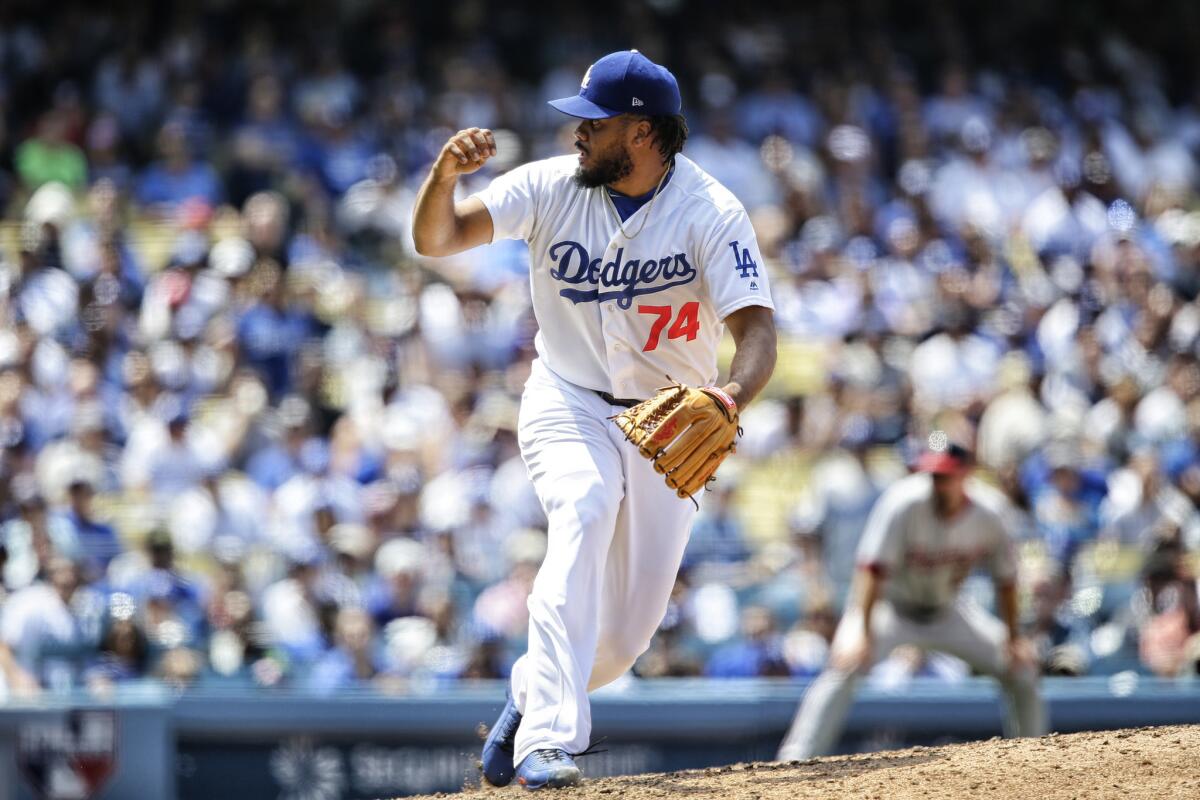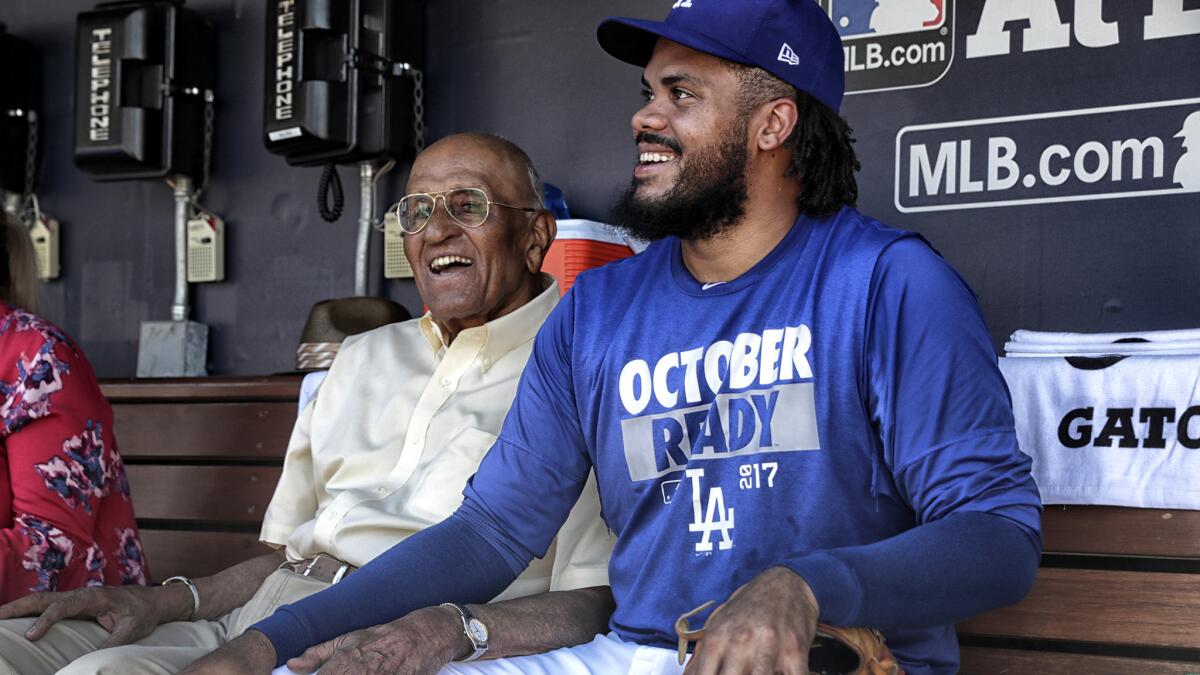How Dodgers closer Kenley Jansen saved his parents’ home, and influenced an island

- Share via
Reporting from Willemstad, Curacao — Verney Jansen pauses his Ford F250 pickup in front of a brown stucco house in a neat middle-class neighborhood of two- and three-bedroom cookie-cutter homes.
But there’s a history that sets this particular residence apart. It is where Verney’s baby brother, Kenley, the Dodgers’ all-star closer, recorded the most important save of his career.
The younger Jansen was a former catcher with a big arm and an uncertain future when he made his major league debut in Los Angeles in the middle of the 2010 season. The same night, nearly 3,500 miles away, his family was about to lose the house in which he grew up.
This house. The brown house. The one across from the dusty dirt lot, 74 Kokolishi street.
A stroke had cost his father his construction company and defending a lawsuit related to the business had robbed the family of what little money it had left.
“Some days we didn’t have food on the table,” Verney Jansen says softly. “It was tough, man.”
Kenley wired home the meal money the Dodgers gave him — pocket change to most big leaguers but a lifeline to his family in Curacao. Soon, he began sending his paycheck home.
By the end of the summer Jansen, wearing the No. 74 on his back, had made 25 appearances, struck out 41 batters and given up just two runs. He also recorded four saves — five including his parents’ house.
::
Jansen has 237 saves since, and last Thursday he recorded the final three outs of a win over the Chicago Cubs that carried the Dodgers back to the World Series for the first time since 1988.
But he hasn’t stopped pitching in at home. Jansen signed a five-year, $80-million contract before this season and several youth teams in Curacao wear uniforms and caps he has provided; others swing bats he paid for, catch with gloves he shipped down, or throw Rawlings baseballs he buys and mails by the boxload to his parents’ house.
“Kenley’s sponsoring this island with a lot of things,” Verney says.
Two years ago, Kenley sponsored a volleyball tournament; it was the best one anyone here can remember.
“Kenley is the first that gives back in a big way,” says Darren Dacosta Gomez, a youth baseball coach on this tiny island in the southern Caribbean that gained its independence from the Netherlands just seven years ago.
Curacao has 160,000 residents, less than half the population of Anaheim, and covers just 171 square miles, making it smaller than San Jose. Yet it has seen 13 of its native sons play in the major leagues since 2000 — the most, per capita, of any country in the world. Another 25 players were on minor league rosters on opening day last spring.
“They’re quality athletes,” says De Jon Watson, the former Dodgers executive who helped Jansen transition from prospect to all-star. “They’re maybe not as talked about as some of the other countries. But these guys are being scouted. They’re not being neglected.”
Over five minor league seasons as a catcher, Jansen didn’t come close to hitting his weight. But playing for the Netherlands in the 2009 World Baseball Classic he showed he could throw, gunning down the speedy Willy Taveras trying to steal third and throwing Ryan Braun out at second from his knees.
So Watson told Jansen to take off the catcher’s gear and get on the mound.
“He called me crying,” Verney Jansen recalls. “I said, ‘What’s your dream? You want to make the majors? Or do you want to be a catcher and come home?’”
In his second minor league season, Jansen caught Clayton Kershaw.
In his second major league appearance, he earned the save in a game Kershaw won.
“It was like, ‘Oh, my goodness, here we go,’” Watson says. “We have something.”
::
Jansen’s fastball touched 99 mph in his pitching debut, evidence of the God-given athletic abilities he inherited from his father Isidro, 65, one of Curacao’s best soccer players, and mother Bernadette, 62, a soccer and volleyball standout.
“We came from a mother and father that loved sports,” Verney says, “so we didn’t have a choice. We got our talent from them too.”
Kenley also got plenty of support from his brothers, whose example and encouragement helped save his career.
Kenley, 30, is a bear of a man at 6 feet 5, 275 pounds, although he’s not much bigger than older brothers Verney, 38, and Ardley, 34, who also played baseball — albeit with far less focus and dedication.
Verney, who has a booming voice but a disarming smile, was a power-hitting first baseman who says he drew interest from the New York Yankees. But the pipeline between Curacao and the major leaguers hadn’t opened yet and Verney, skeptical someone from the island could make it in the U.S., quit baseball and went to college.
Four years later, Ardley, a swift outfielder, accepted an offer from the Atlanta Braves. But he partied his career away, playing just five games above A-ball during seven minor league seasons in which he had more strikeouts than hits.
“Kenley was watching me, and he didn’t do the same,” says Ardley, who now plays for one of the many amateur teams his brother either owns or supports. “He never partied. He never went out.”
As a boy, Kenley would play pick-up games in the vacant lot across from his house or, when everyone else went home, strengthen his arm by bouncing tennis balls off the concrete-block wall in front of his house. By the time he got to high school, he was regularly ditching class and catching a bus to the field where Ardley was practicing.
“My mom got in an argument with him,” remembers Ardley, whose shaved head, full beard and diamond-stud earrings leave him looking a bit like a bald David Ortiz. “She told him, ‘That’s what you want? That’s not an easy life.’ And Kenley said, ‘Don’t worry mom, I’ll make the major leagues.’”
His brothers did what they could to make sure of it.
“Kenley saw my brother and I and didn’t want to do that,” says Verney, who regrets not signing with the Yankees. “We made sure he was disciplined. I said, ‘Remember what happened with Ardley’.”
Where Kenley’s brothers were loud and boisterous, he was quiet and reserved, a trait he carried into the Dodgers clubhouse partly at Watson’s urging.
“He’s worked his tail off to get to where he is today,” says Watson, now a special assistant to the general manager with the Washington Nationals. “When he first got there, I would tell him, ‘Shhh. Keep your mouth closed and your ears open and be humble. They’ll let you know when it’s time to speak.’”
Last season, manager Dave Roberts told Kenley it was time, urging him to step up and become a team leader. Not only was he liked and respected by his teammates, but Kenley had language skills — like most people in Curacao, he speaks four languages: Papiamentu, the local dialect, Dutch, English and Spanish — that were invaluable in a diverse clubhouse.
“I’ve challenged Kenley,” Roberts says. “We’ve had a lot of spirited conversations about what it takes to be a champion. Kenley is all about the team winning a championship.
“Players know, coaches know, who’s in it for the right reasons and who’s in it for themselves.”
When Kenley enters the clubhouse now, the first thing he does is turn the chair in front of his locker around, so he’s facing his teammates and the media, a universal sign that his office is open to whomever wants to come over and talk.
“I’ve got to give it to Dave,” he says. “He pushed me and made me mature and become the guy I am today. You’ve got to know when to push people.
“They’re going to push me, motivate me. And I’m going to do the same thing.”
::
There isn’t a blade of grass on the field where Kenley Jansen learned to play baseball. The mound is a bump, the bases untethered slips of white plastic about the size and thickness of a newspaper page.
Five rows of concrete bleachers, painted a noxious lime color, abut the green dugouts. Dirt and trash are piled up down the right-field line and a rooster crows incessantly from a house nearby.
For the Jansens and others in Curacao, the dusty diamond is no less a shrine than Yankee Stadium or Wrigley Field. More than a dozen major leaguers played at Shon Ki Ballpark, named for the man who coached there for four decades.

The Jansen brothers might have never have played here had their grandparents not lived close by. Because both parents worked, the boys stayed with their grandparents after school. Nearly every afternoon, Shon Ki Nicasia would drive into the neighborhood, honk his horn, collect whoever responded, and take them to the field to practice.
Aside from the Jansens, others who answered the call included Yankees shortstop Didi Gregorius, the Angels’ Andrelton Simmons, a two-time Gold Glove-winning shortstop, and former Colorado Rockies pitcher Jair Jurrjens.
Kenley says Nicasia “really helped me,” but the coach died the year his star pupil made his big-league debut. Jansen honors his memory by coaxing along another generation of baseball players, donating equipment, time and his example.
On a recent Friday afternoon, Verney wheels his pickup into the parking lot of another grassless field where 51 boys and one girl, ages 8 to 14, are finishing a week-long baseball camp.
Fermin Coronel, a former officer in the Dutch navy and a scout for the Cincinnati Reds, estimates more than 1,000 kids are playing organized baseball in Curacao, nearly double the number from Kenley’s childhood. The rough fields have helped honed their footwork and hand-eye coordination, one reason why more than half the major leaguers from the island have been infielders.
“Every neighborhood has a baseball field, and a team,” says another youth coach.
A couple of nights earlier, the kids watched the American and National league playoffs on TV, the infielders cheering for the Yankees and Gregorius while the pitchers rooted for the Dodgers and Jansen.
Now both men, aware of their ability to influence and inspire the next generation of players from Curacao, are doing what they can to give back.
“I love my island. I would never forget about my people,” Jansen says.
Rack up another save for the closer.
The Los Angeles Dodgers in the 2017 World Series
Follow Kevin Baxter on Twitter @kbaxter11
ALSO:
Tommy Lasorda is ready for one more World Series title
Dodgers vs. Astros: How the teams match up for the World Series
The Dodgers’ road to the World Series: highlights from the NLCS
More to Read
Are you a true-blue fan?
Get our Dodgers Dugout newsletter for insights, news and much more.
You may occasionally receive promotional content from the Los Angeles Times.











